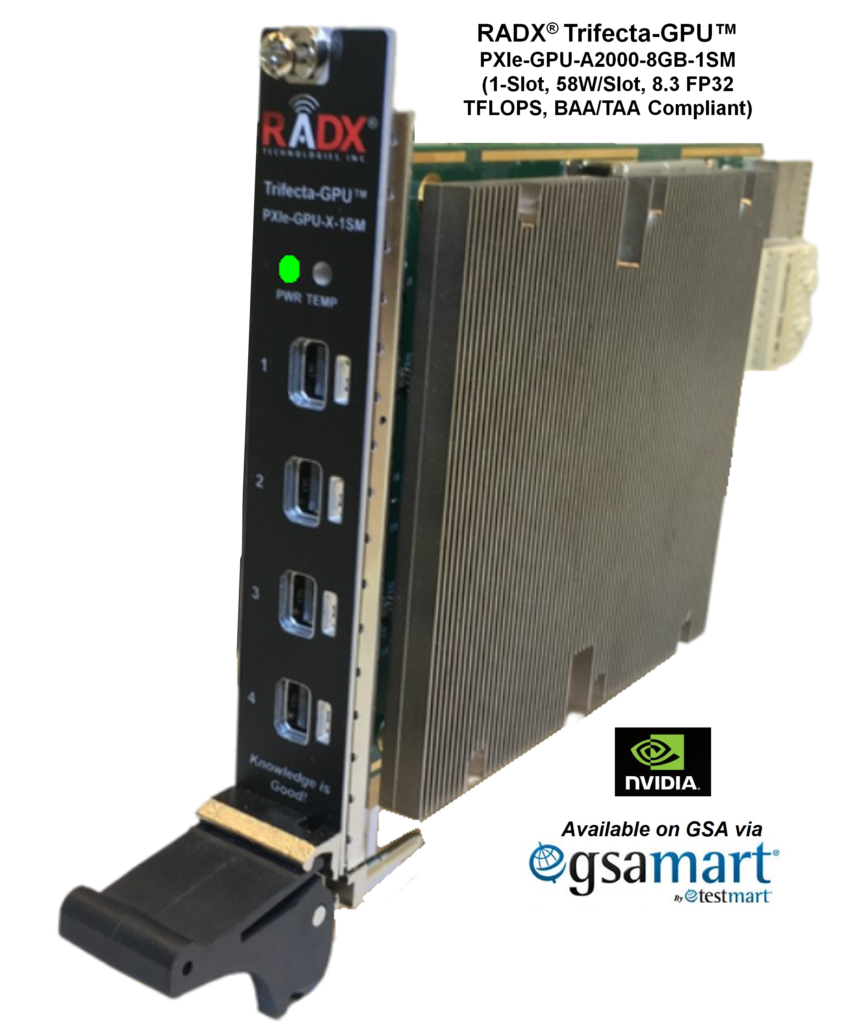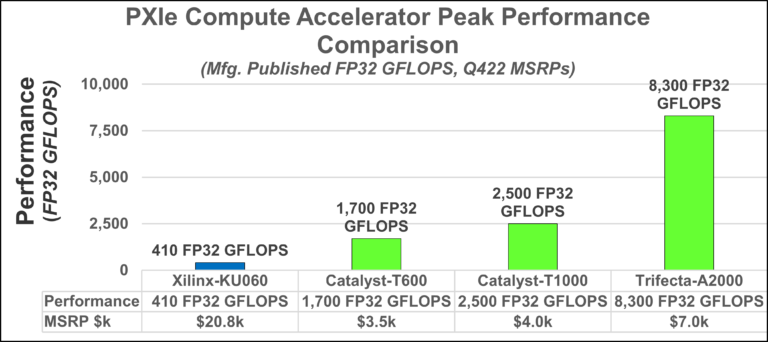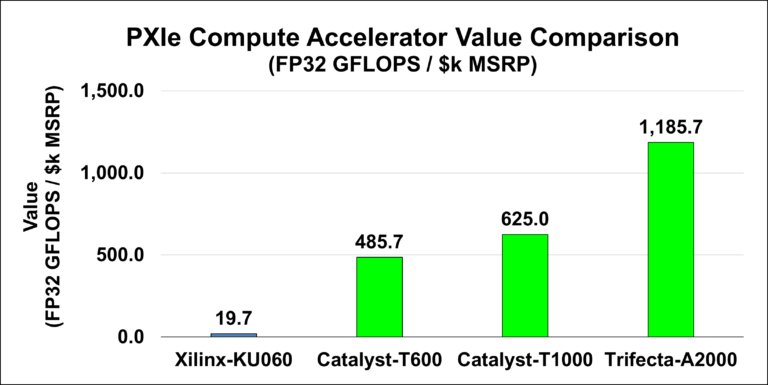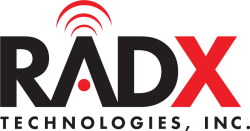Trifecta-GPU
PXI GPU | PXIe GPU | CPCI GPU | CPCIe GPU
RADX Trifecta COTS, PXIe/CPCIe GPU Modules Bring Easy-to-Program NVIDIA RTX A2000 Embedded GPU with 8.3 FP32 TFLOPS Compute Performance to Modular T&M and EW Markets for Advanced, Software-Defined, Signal Processing and Machine / Deep Learning Inference Applications
The Trifecta-GPU™ Family of COTS PXIe/CPCIe GPU Modules are the first COTS products that bring the extreme compute acceleration and ease-of-programming of NVIDIA® RTX® A2000 Embedded GPUs to PXIe/CPCIe platforms for modular Test & Measurement (T&M) and Electronic Warfare (EW) applications.
Designed to complement RADX Catalyst-GPU products announced earlier this year, Trifecta-GPUs deliver even greater compute performance by employing NVIDIA RTX Embedded GPUs. Announced at AOC 2022 in October 2022, the first Trifecta-GPU model is based on the RTX A2000, which features 8GB of GDDR6 DRAM, PCIe Express 4.0 and up to 8.3 FP32 TFLOPS peak compute performance. As with Catalyst-GPUs, Trifecta-GPUs feature comprehensive support for MATLAB™, Python, and C/C++ programing, as well as industry-best support for virtually all popular computing frameworks, making Trifecta-GPUs extremely easy-to-program for both Windows and Linux operating environments. With their extreme levels of performance, Trifecta-GPUs are ideal for the most demanding Signal Processing, Machine Learning (ML) or Deep Learning (DL) inference applications for AI-based signal classification and geolocation, semiconductor & PCB testing, failure prediction, failure analysis, and other important missions.

Trifecta PXIe/CPCIe GPUs – Flexible and Scalable
Many PXIe and CPCIe chassis are limited to 38W/Slot for input power and thermal dissipation. To address this, Trifecta-GPUs are available in both single and dual-slot configurations, with dual-slot configurations for 38W/Slot conventional and legacy chassis and single-slot configurations for NI Chassis that support 58W/Slot and 82W/Slot.
With peak performance of 8.3 FP32 TFLOPS, the new Trifecta A2000 GPU delivers compute acceleration that’s almost 5x that of the Catalyst T600 GPU and over 20x that of a Xilinx® Kintex® Ultrascale® KU060 FPGA. Until now, this level of compute acceleration has not been available in PXIe/CPCIe systems. With Catalyst and Trifecta PXIe-GPUs, users can now conduct fast and accurate signal analysis and machine and deep learning on acquired data – directly in the PXIe/CPCIe systems where the data is acquired.

In terms of compute acceleration value, the Trifecta-GPU sets a new standard for FP32 GFLOPS per $k MSRP. With peak FP32 performance of 8.3 TFLOPS and a list price of $6,999, the Trifecta-A2000 delivers almost 2 orders of magnitude better price performance than the most popular PXIe FPGA module. Plus, Trifecta GPUs support arbitrary length FFTs and other signal processing primitives to provide unmatched signal resolution, which is important for Low Probability of Intercept (LPI) signal detection. Also Trifecta-GPUs provide industry leading acceleration for machine and deep learning applications, including signal classification.

Easy-to-Program via MATLAB, Python, C/C++ and LabVIEW
One of the most important aspects of Catalyst and Trifecta GPUs are their ease-of-programming, which stems from their underlying NVIDIA GPUs that support programming via MATLAB™, Python and C/C++ that enables compute acceleration via NVIDIA CUDA® and OpenCL®. This ease-of-programming has resulted in NVIDIA GPUs becoming the most popular compute accelerators in the world today – with millions of engineers, developers and computer scientists using NVIDIA GPUs to accelerate their applications. Catalyst and Trifecta GPUs support both Windows and Linux operating environments. In addition, Catalyst and Trifecta GPUs support popular AI and other frameworks, including LabVIEW™, MATLAB™, TensorFlow, PyTorch, RAPIDS AI and RAPIDS cuSignal, to name a few.
RADX Catalyst and Trifecta PXIe GPUs Support Virtually All Popular Software Compute Acceleration Frameworks

For many PXIe users, integration of GPUs into LabVIEW applications is quite important. Fortunately, LabVIEW features interfaces for calling Python, C/C++ or MATLAB libraries from LabVIEW and LabVIEW CVI, which make integration straight forward and efficient. Accordingly, adding Catalyst or Trifecta GPU acceleration to LabVIEW-based PXIe applications is relatively quick and easy, especially when compared with the level of effort required for FPGA-based acceleration.
About Trifecta-GPUs
Trifecta-GPU models announced at AOC 2022 are based on the NVIDIA Embedded RTX A2000 GPU, and are available in a single-slot and a dual-slot PXIe module. Trifecta-GPUs support PCIe Gen 4 x8 interfaces for optimal, future-proof performance and 4 x miniDP outputs for multi-monitor applications with resolutions up to 4k. The Trifecta A2000 GPU supports 8GB of GDDR6 memory, up to 8.3 FP32 TFLOPs and a Total Graphics Power (TGP) of 58W. The single-slot module is ideal for NI PXIe-1092 or PXIe-1095 chassis, which support 58W/Slot or 82W/Slot. The dual-slot version dissipates 29W/Slot TGP, which makes it suitable for all NI and 3rd-party PXIe chassis.
Pricing and Availability
Trifecta A2000 Single-Slot and Dual-Slot GPUs have list prices of $6,999 and $7,499, respectively. Lead time for single units is typically 30 days, starting in Q123. Trifecta-GPUs are BAA & TAA Compliant and will be available on GSA via TestMart (https://tinyurl.com/muk72crx).
